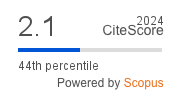Advancing IoT Security with an Innovative Machine Learning Paradigm for Botnet Attack Detection
DOI:
https://doi.org/10.4108/eetiot.4521Keywords:
Machine Learning, Feature Extraction, Botnets, Internet of ThingsAbstract
INTRODUCTION: In contemporary society, everyday operations are greatly improved by the Internet of Things (IoT), which connects physical devices to provide digital services. IoT technology offers unified services and streamlines activities across various domains, ranging from remote monitoring to sophisticated welfare systems. However, the growing number of IoT devices presents a security concern. Many of these devices are susceptible to exploitation, leading to diverse vulnerabilities.
OBJECTIVES: Resource-constrained IoT devices become prime targets for botnet attacks, manifesting in various forms and penetration methods. Despite numerous research efforts introducing multiple approaches for detecting botnet attacks in IoT, existing methods often fail to achieve satisfactory detection rates.
METHODS: Additionally, these approaches struggle to comprehensively analyze the diverse communication networks within the expansive realm of IoT devices. This study proposes an innovative machine-learning framework for detecting IoT botnet threats to address these limitations.
RESULTS: This conceptual framework exhibits a remarkable capability to identify a spectrum of botnet attacks, showcasing a detection accuracy of 99.5 per cent, significantly surpassing the performance of other prevalent machine-learning approaches.
CONCLUSION: Through this research, we aim to enhance the security paradigm of IoT networks, ensuring robust protection against evolving botnet threats in the dynamic landscape of interconnected devices.
Downloads
References
[1] Akmandor AO, Hongxu YIN, Jha NK. Smart, secure, yet energy-efficient, Internet-of-Things sensors. IEEE Trans Multi-Scale Comput Syst. 2018;4(4):914-930.
[2] Panda M, Abd Allah AM, Hassanien AE. Developing an efficient feature engineering and machine learning model for detecting IoT-botnet cyber attacks. IEEE Access. 2021;9:91038-91052.
[3] Mosenia A, Jha NK. A comprehensive study of internet-of-things security. IEEE Trans Emerg Top Comput. 2016;5(4):586-602.
[4] Yin L, Luo X, Zhu C, Wang L, Xu Z, Lu H. ConnSpoiler: Disrupting C&C communication of IoT-based botnet through fast detection of anomalous domain queries. IEEE Trans Ind Inform. 2019;16(2):1373-1384.
[5] Sarker IH, Abushark YB, Alsolami F, Khan AI. Intrudtree: A machine learning-based cyber security intrusion detection model. Symmetry. 2020;12(5):754.
[6] Jia Y. Flowguard: An intelligent edge defense mechanism against IoT DDoS attacks. IEEE Internet Things J. 2020;7(10):9552-9562.
[7] Doshi K, Yilmaz Y, Uludag S. Timely detection and mitigation of stealthy DDoS attacks via IoT networks. IEEE Trans Depend Secure Comput. 2021.
[8] Alharbi A, Alsubhi K. Botnet detection approach using graph-based machine learning. IEEE Access. 2021;9:99166-99180.
[9] Moustafa N, Turnbull B, Choo KKR. An ensemble intrusion detection technique based on proposed statistical flow features for protecting network traffic of Internet of Things. IEEE Internet Things J. 2018;6(3):4815-4830.
[10] Le HV, Ngo QD. V-Sandbox for dynamic analysis IoT botnet. IEEE Access. 2020;8:145768-145786.
[11] Antonakakis M, April T, Bailey M, Bernhard M, Bursztein E, Cochran J, et al. Understanding the Mirai botnet. 26th USENIX Security Symp (USENIX Security 17). 2017:1093-1110.
[12] Popoola SI, Adebisi B, Hammoudeh M, Gui G, Gacanin H. Hybrid deep learning for botnet attack detection in the Internet-of-Things networks. IEEE Internet Things J. 2020;8(6):4944-4956.
[13] Dange S, Chatterjee M. IoT botnet: The largest threat to the IoT network. Data Commun Netw. Springer, Singapore; 2020:137-157.
[14] Wang TS, Lin HT, Cheng WT, Chen CY. DBod: Clustering and detecting DGA-based botnets using DNS traffic analysis. Comput Secur. 2017;64:1-15.
[15] Termanini RD. The Nano Age of Digital Immunity Infrastructure Fundamentals and Applications: The Intelligent Cyber Shield for Smart Cities. CRC Press. 2018.
[16] Muthu B, Sivaparthipan CB, Kumar RL. Trust-based energy-efficient protocol over MANET using PTORA and RRFO. Wireless Pers Commun. 2024.
[17] Punitha P, Sivaparthipan CB, BalaAnand Muthu, Lakshmana Kumar R. A policy-configured resource management scheme for AHNS using link reliability K-means clustering algorithm and Weibull distribution-based blue monkey optimization. Int J Commun Syst. 2024;37(12):e5850.
[18] Punitha P, Lakshmana Kumar R, Revathi S, Premalatha R, Aiswarya RS. Secured framework with a hash function-enabled keyword search in cloud storage services. Int J Coop Inf Syst. 2024;33(3):2450001.
[19] Lakshmana Kumar R, Jayanthi S, BalaAnand Muthu, Sivaparthipan CB. An automatic anomaly application detection system in mobile devices using FL-HTR-DBN and SKLD-SED K-means algorithms. J Intell Fuzzy Syst. 2024;46(2):3245-3258.
Downloads
Published
Issue
Section
License
Copyright (c) 2025 Lakshmana Kumar R, Dinesh Kumar V. K, Punitha P

This work is licensed under a Creative Commons Attribution-NonCommercial-ShareAlike 4.0 International License.
This is an open-access article distributed under the terms of the Creative Commons Attribution CC BY 4.0 license, which permits unlimited use, distribution, and reproduction in any medium so long as the original work is properly cited.




